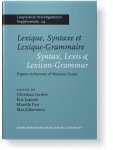Some Elements for an Empirical Approach to the Study of Meaning
This article argues that meaning must be analyzed in terms of a notion of description. That notion is taken to apply quite generally beyond the language faculty to other cognitive and perceptual modalities. Descriptions are gathered into families, each family having the structure of a semilattice. The semilattice connective corresponds to the and connective of natural language. One distinguishes between pure descriptions and mixed descriptions: a mixed description obtains when pure descriptions are conjoined by means of Boole's connective +, corresponding to the exclusive or of natural language. To illustrate, the description associated with a yes-no question is a mixed description, and so is the description associated with such determiners as English any or English wh-. The connective + is naturally extended to families of descriptions. In turn, mixed descriptions may themselves be arranged into families, with each family having the (really dual) semilattice structure of a family of pure descriptions. Finally, descriptions may be related by the connective IF-THEN. That connective is construed as a mapping between mixed descriptions. In particular, the focus structure of an utterance is defined in terms of that connective. Given a description UXW with subdescription X, X is the focus of UXW iff. the relation IF X is a description of t, THEN UtW is a description hold. The approach adopted ultimately derives from Chomsky's critical appraisal of theories of meaning that rely on some notion of "reference to a world"; see Chomsky (1992, 2000).
